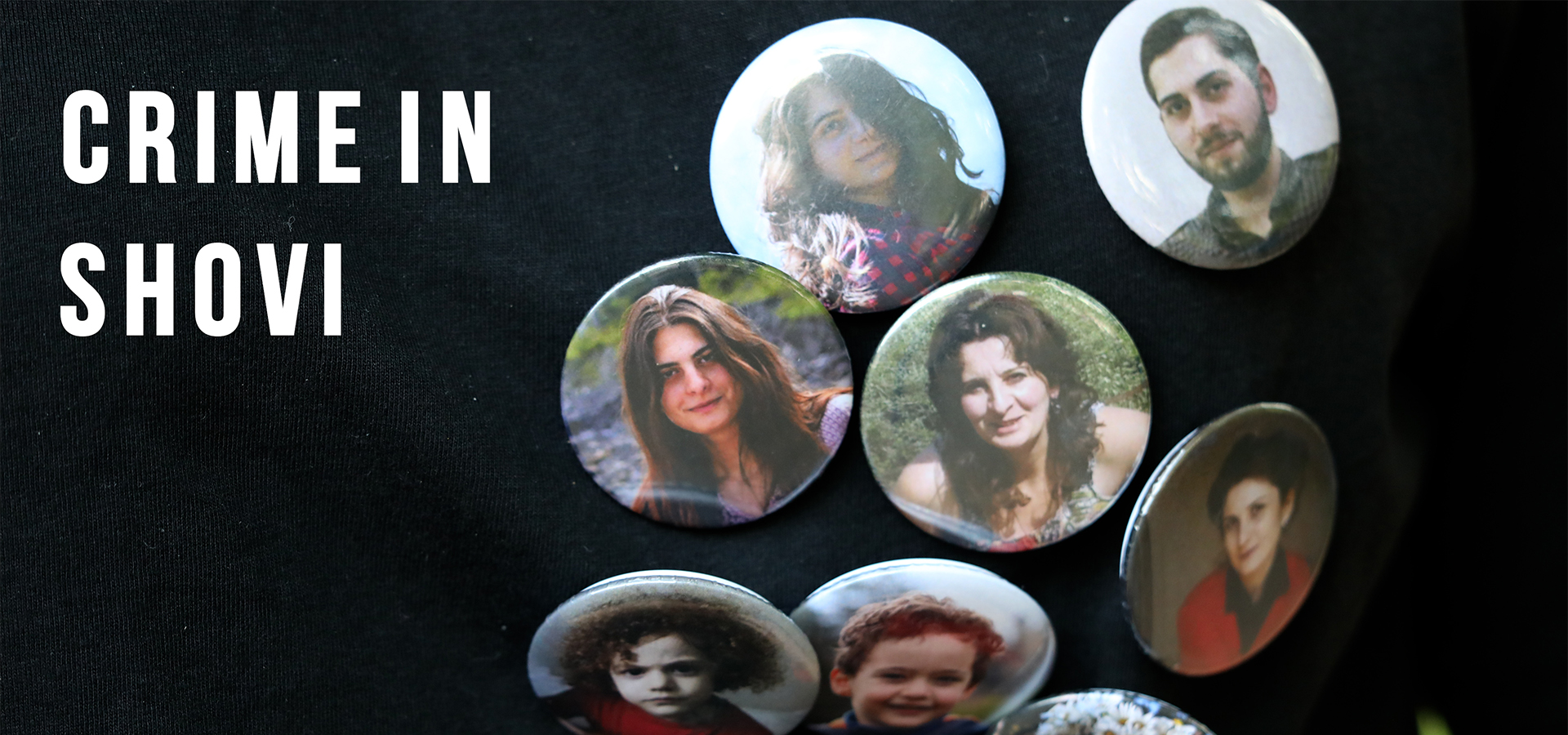Shovi moments after disaster and Shovi case 80 days later. What happened in Shovi? Was a natural disaster in the resort foreseeable, and could the lives have been saved? A flood occurring 3 years back in the same valley, same river, and an unfinished dam from 3 years ago, which was supposed to save lives. What turned a flourishing resort into a site of an unprecedented catastrophe? How is the investigation into the Shovi case being conducted? What did the Shovi resort project envision, with 18-meter hotels planned directly in the path of a predictable landslide. A rescue operation ‘‘whoever survived, survived’’.
Moments after disaster
‘‘Eto please, I’m begging you… a helicopter… we are dying out here’’, Eter Arsanidze, the head of the Racha Community Organization, received this voice message from a friend on August 3, 15:26. She couldn’t view it right away. 3 minutes later, Lana Jeladze video calls her, telling her that they were caught in a landslide about half an hour ago, they called 112 many times, but the rescuers have not appeared yet, and asks her to pass the word that they need urgent help. Georgian News broke the first news about the disaster in Shovi at 15:51.
Mariam Berianidze, a vacationer caught in the landslide: ‘‘We were initially struck with an earthshattering noise, as if a helicopter it crashing onto your head. Suddenly we see a tree topple, then another, and another, and then the entire mountain along with its vegetation breaks away and sets off for us. I remember the moment my husband grabbed our son, picked him up and we sped downslope. We were hit by the first wave on the Kaltsi bridge and were dragged 20 meters, then another one. My pants flew off and my husband's shoes were yanked off his feet along with his socks. Gives you an idea of the force and the speed of the current. The mudslide was carrying nearby cottages along with us.
A moment before the torrent hit us, my husband turned his back to it, held our baby to his chest, and I pressed my arms against his shoulders from the front, to somehow brace and keep our balance so as not to get swept off our feet at the first blow, because getting out of there seemed impossible. We held on for a few seconds and as we felt we were losing our footing, I remember us silently glancing at each other as if to say our final goodbye.
Davit Jeladze, a vacationer caught in the landslide: ‘‘The sound was deafening. The sound alone could have probably killed someone. I picked up my niece, hugged her tight, and turned my back to the oncoming torrent. The wave hit us and thrust us very far.
Up to our waists in mud, can’t move, can’t walk. My niece’s whole body is submerged in the mud, only her face and ears are sticking out and she’s looking at me, she’s still conscious.
I keep telling myself I can’t let go of her hand or I will never see her again.
Eter Arsanidze: ‘‘During one of our calls, Lana tells me that her brother and niece were struck by a huge wave and hurled away, and she is dead scared they might not have made it. She explained that the affected area extended as far as the eye could see. She was afraid they wouldn’t survive another wave and the whole family would be buried alive. I call the police once more. They confirm that they received the reports, passed it on, and were awaiting a response. They advised the people, who escaped death twice and are still in peril, not to panic.’’
Mariam Berianidze: ‘‘We crawled out somehow and reached the pink house, the only one that was spared. At some point my husband covered our son’s eyes, we thought we wouldn’t make it out of there. Not in one piece at least. We kept crawling, fighting our way, we got stuck on a 5-meter-deep mud where you’d sink even sitting down.
We tell 112 that a massive landslide has occurred, we are stuck in the vicinity of Sunset Shovi Hotel, the road has been swept away and the entire Shovi has been engulfed. The operator tells us that our message has been relayed and the rescue team will be on its way. We tell them that no vehicle can reach here, forget ground rescue, we need a helicopter.
The young couple next door managed to flee the house and climb over the fence, preceding us by a few steps, but they died on the Kaltsi Bridge right in front of us.’’
Davit Jeladze: ‘‘There were fifteen of us on the bridge at first, and thirteen of us managed to escape. A Georgian boy and a Russian girl were there. ‘‘That’s it, we’re done’’ the boy kept shouting. I never saw them again after that.’’
Mariam Berianidze: ‘‘They climbed a tree, the flood completely filled the ravine it was standing in, tore the tree off and carried it away along with them.
I remember another couple in a car, but I can’t recall the color or the make of the car, everything is blurry, all I remember is their screaming as they were being dragged away.
I remember a moment when my husband went aside, well, when I say went, he plowed his body through the mud for our son not to overhear, and asked the operator on the phone ‘‘just tell me straight, is the helicopter coming or not, my wife and child are dying out here.’’ Only men from Racha were able to reach us in about three hours.’’
Such is the reconstructed picture of the first moments of the disaster that struck Shovi, pieced together according to the accounts of Dato Jeladze, Mariam Berianidze, and Eter Arsanidze.
‘‘Where is the helicopter?’’
‘‘We were seeing arms sticking out and people above their waist. Some were buried, others so weakened they were just sitting on the mud,’’ tells us Vazha Tsetsadze, a rescue volunteer. Vazha was returning from Ambrolauri to Oni when a relative informed him about the natural disaster in Shovi. He was only halfway, but still beat the police and rescuers to the site to help people. He reached the epicenter of the disaster along with four other locals. First, they walked through the forest, then they laid a path across the mud, so as not to sink, using wooden planks fished from the debris of cottages destroyed by the mudslide, and reached the survivors. ‘‘The first question was, where is the helicopter.’’
The helicopter still hadn’t arrived three hours after the disaster struck Shovi. A small group of the Oni Rescue Service was the first among the state agencies to arrive on the scene, although local volunteers had already started the rescue efforts.
The disaster took 33 lives, while the works report of the Minister of Internal Affairs regarding the conduct of special services in response to the disaster was met with lengthy applause by the majority MPs.
‘‘Rescue works in Shovi started immediately, and not with a 3-hour delay. Due to difficult meteorological conditions, the rescue helicopter mobilized in Kutaisi was unable to take flight. Two helicopters of the Border Patrol departed from Tbilisi,’’ the minister cited bad weather three times as the reason why the helicopter could not take off from Kutaisi at all, and why the ones sent from Tbilisi took longer than a car.
‘‘The first helicopter took off from Tbilisi at 16:54. Despite challenging weather, it joined the rescue operation about three hours after the disaster,’’ said Vakhtang Gomelauri.
Mountain Stories pulled weather data for August 3 from the National Environmental Agency. On that day, the weather was equally good in the western and eastern regions. The wind speed was 10-15 m/s – well within the normal flight envelope of the state-owned Mi-8 helicopter, which can comfortably operate at twice the wind.
Despite the minister’s determination, that the delay of the helicopter cannot be blamed on bad weather is corroborated by Glola resident Gia Bichashvili and mountaineer Tornike Matsaberidze:
‘‘The visibility was absolute, the sky was clear and sunny’’; ‘‘there were no clouds, wind, or precipitation.’’
The helicopter arrived in the epicenter of the disaster in three-and-a-half hours. By this time, a lot of rescuers had already arrived.
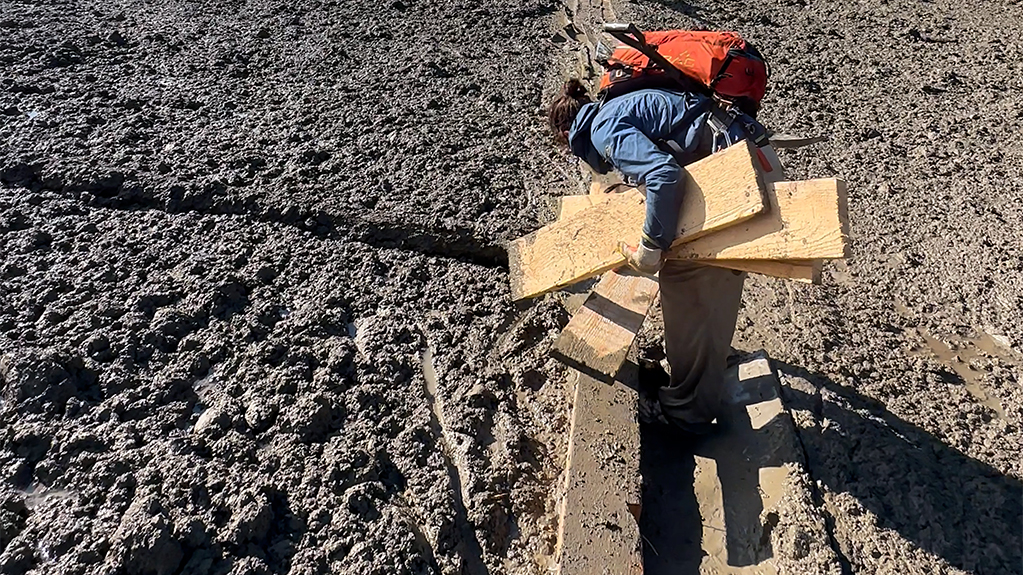
Rescue volunteers arranging a path to extract the survivors. Photo © Mtisambebi.ge
Rescuers without equipment and suspended search & rescue operation
‘‘The pilots had no clue where to look for what. Aren’t pilots supposed to know what they are flying over? Shouldn’t someone determine ground references and terrain layout? Rescuers, too, were laying planks over the mud and cluelessly heading in random directions. They went towards houses that were still intact, and that had been deserted for years. They could have just asked us whether anyone was expected to be there, not to waste time before nightfall,’’ Marita Gutashvili lost her brother and sister, aunt, three cousins, and her three young children in the disaster.
The flood altered the environment so much that even the locals were struggling to orient themselves. A few minutes after the disaster, the journalists of Mountain Stories who entered the valley through detours saw for ourselves.
Neither in the first hours nor in the following days did the rescuers have the special equipment that is meant for such a scenario and would allow them to effectively traverse 25 hectares covered with mud.
‘‘They call it Tkhilmari [snowshoe] in Georgian, and is common in all highland regions of Georgia,’’ according to Tornike Matsaberidze, his friends made makeshift snowshoes on August 5 by strapping boots to planks and were able to reach areas no one has been in, in the day and a half that passed.
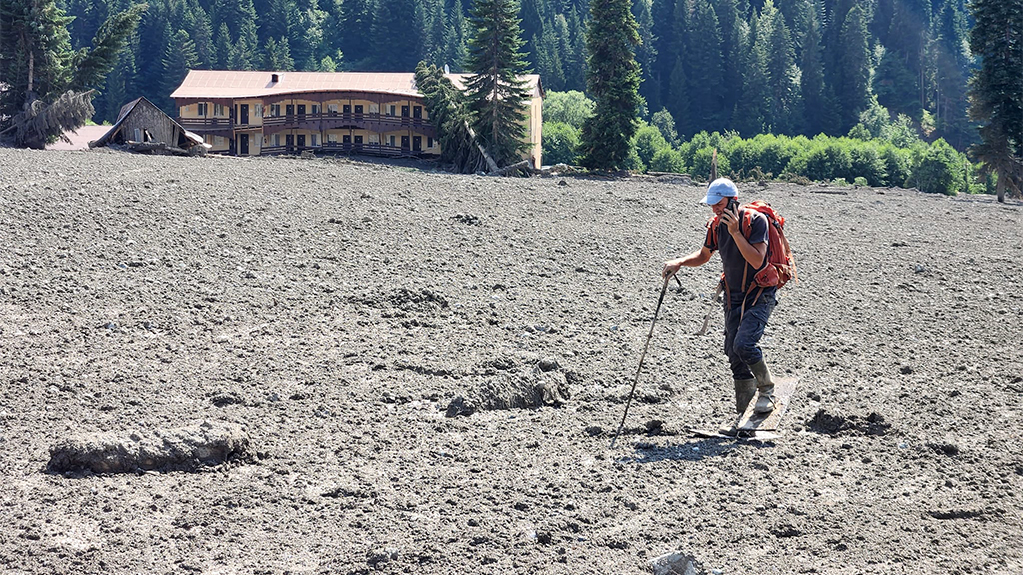
Rescue volunteer Nika Gugeshashvili with makeshift snowshoes. Photo © Tornike Matsaberidze
Mountain Stories learned about the first casualty at half past eight. The first body was found by an employee of the border police. The authorities undoubtedly had information about this much earlier than the media.
The Ministry of Internal Affairs kept promising to clarify the information on casualties for a few hours. By 9:00 p.m., we learned about 2 more victims, and the story was published on the Mountain Stories website.
At the time, state-aligned channels were reporting that the rescue operation was completely successful. ‘‘The five-hour rescue operation ended with complete success. No one was injured, although the damage is extensive,’’ reported Rustavi 2 at 9:00 p.m. in their main newscast.
By this time, the helicopters had already stopped working for at least an hour.
‘‘Send a helicopter for a nigh search, please… they won’t make it through the night. There are kids aged 2, 3, and 7. Have some sympathy for those children. I’m begging you. My whole family is there and I don’t know what state they are in,’’ Giorgi Dudashvili plead for help from the government on the air of critical media.
‘‘The helicopters stopped working at night, but not the firefighters and rescuers. The rescuers worked through the night.
Are you not ashamed in front of those rescuers, those of you who say that the rescuers apparently called it a night to rest and continued in the morning,’’ With this statement, the Minister of Internal Affairs is lying again!
On August 3, the rescuers suspended search & rescue as soon as the darkness fell - The locals who were in constant touch with them confirm this with without a doubt. The local climbers offered rescuers to deploy their zipline to cross the river.
Gia Bichashvili, Glola resident: ‘‘We had a plain view across, if anyone entered, we would know.’’
Tornike Matsaberidze, mountaineer: ‘‘I was on the other side of the river, I told them I can deploy a zipline, and if they secure it we can both move across. They told me the rescue is suspended overnight and there is no point, let’s talk in the morning.’’
‘‘5 thermal imaging drones have been scanning the site throughout the night. During the search drills by helicopters, drones, and fire & rescue teams, no survivors were detected on the surface of the mud,’’ says the Interior Minister.
In fact, no one has witnessed a drone of the rescue service in Shovi during the day or night of August 3.
Tornike Matsaberidze: ‘‘We haven’t heard or seen any drone during the night or on the following morning. There was a private drone on August 4 belonging to a boy from Kutaisi.’’
Marita Gutashvili: ‘‘We had a plain view of the whole area and if there was a drone, we would at least hear the buzzing or see the flashing lights. Every half hour I would approach them to ask if they found anyone, but they just stood there and turned a deaf ear.’’
Gia Bichashvili: ‘‘On August 4, activists from Kutaisi arrived with their drones to help with the search, but were not permitted to fly them. They were told that the rescue service drone would instead arrive shortly. I said there might be people in need out there right now, but they told us that the activist’s drones would interfere with their drone when it got there.’’ At first, they said their drones were already in the air, but I’d been there all day and hadn’t seen or heard a single drone. They were straight up lying to our faces. They didn’t let us launch drones until we physically challenged them.’’
Belatedly, the defense forces were also involved in the search & rescue operation. Only on the 3rd day did they start using the prefabricated footbridges, which allowed the military personnel and rescuers to explore and move around more of the area.
The authorities were trying by all available means to gain complete chokehold over the information coming out of Shovi. This is why they refused to allow the volunteers from Kutaisi to launch their drone on the first day and obstructed the media as much as possible in the days that followed.
Officials in shoe covers kept tirelessly echoing several common messages about the August 3 disaster. First – this was impossible to predict.
Where did death come from
According to the case files, the police received the first call from Shovi at 15:07. In exactly 2 minutes, the National Environmental Agency publishes a warning statement on Facebook, which says that landslides are expected to occur in the mountainous areas of the country. The announcement is a prediction of what had already happened, affected over 25 hectares, already destroyed roads, bridges, and cost dozens of lives, and what the survivors had already called in to the police.
‘‘That the disaster had been predicted in 2021 is a shameful lie. How can you predict the breaking of the ice from a glacier 2 years in advance? I am not even going to go any deeper into this,’’ said the Chairman of the ruling party Georgian Dream, Irakli Kobakhidze.
Mountain Stories did decide to go deeper into this. To find out whether there were any incidents in the recent past that indicated impending dangers. For that, there was no need to scale the mountains. We saw the evidence of what brought the deaths of people and then the masterful demagoguery from the government right there in the epicenter of the disaster.
‘‘This [Buba] river has not flooded or exhibited any dangerous tendencies in the last 100 years,’’ the author of this statement is a high-ranking official, Minister of Environmental Protection and Agriculture Otar Shamugia.
The government says that the Buba River has never caused any trouble. This is the same ‘harmless’ river that flooded on July 7 of 2017, partially submerged the area of cottages and damaged the surrounding infrastructure.
Gia Bichashvili: ‘‘This should have been a sign that the danger was there, and the government should have taken precautions. Conduct a study, install reinforcements, or cancel the resort altogether.’’
Buba River offered a bigger glimpse of its potential 3 years ago, on July 29, 2020. This time, the overflowing water and mud from the river completely flooded the area of the cottages and the living and dining rooms located there, the road to the resort was caved, and 2 cottages were destroyed. As a result, Shovi was cut off from the outside world.
Marita Gutashvili: ‘‘There were no casualties back then, but I was still frantically calling the authorities asking to send a helicopter and address the situation in some way.’’
Then, too, vacationers were evacuated using the border police helicopter.
After a natural event of such scale, the authorities were obliged to examine the glacier and assess the risks.
Marita Gutashvili: ‘‘No one, say a geologist, approached us to inquire on what we witnessed, whether there have been similar incidents before, on what scale, and what was damaged. No one cared.’’
Gia Bichashvili: ‘‘In my childhood, I remember geologists and hydrologists used to show up every spring, climbed these mountains, and stayed there in tents for months at a time to study the glacier, the mountain, assess by how much the glacier has lowered and so on. There have been no such efforts in recent years. We are there all the time, no one could have possibly gone up there without any of us noticing.’’
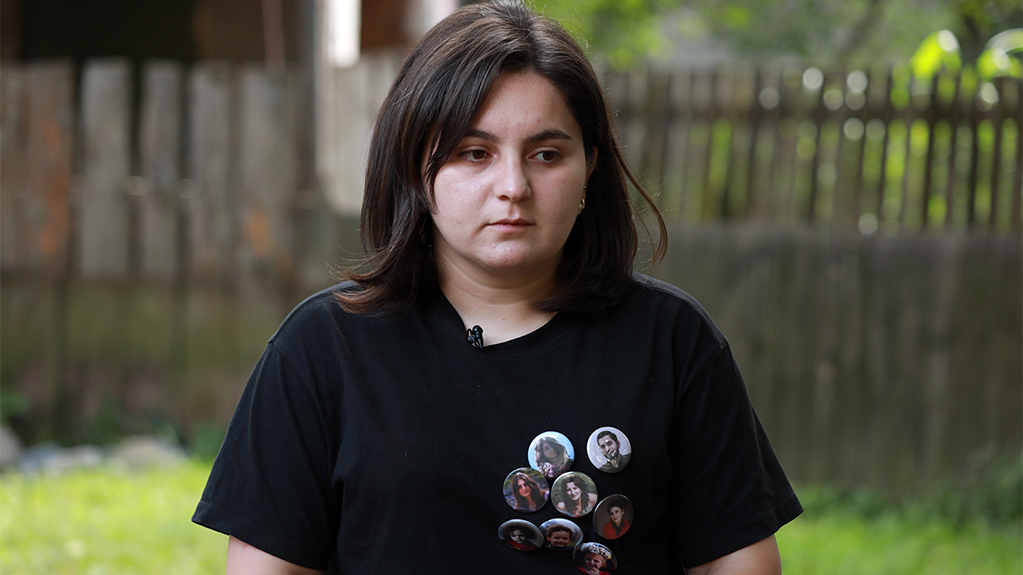
9 Family members of Marita Gutashvili were killed in the landslide of August 3. Photo © Mtisambebi.ge
The Buba River has been under long-term observation of the Institute of Geography, since the 60s. As a result of climate change, a third of the Tbilisa glacier, where this river originates, has melted. And despite the fact that a resort lies at its bottom, monitoring has no longer been carried out in recent years.
Where the river makes a sharp turn is where the Mamisoni cottages are located. It was there that the water overflowed the banks in 2020.
Mamisoni cottages are located where the river makes a sharp turn, and that’s exactly where the river flooded in 2020. Along with Bubba, Chanchakihi and Rioni also swelled, destroying bridges and roads. In order to restore the infrastructure, the state developed several projects and allocated 60 million GEL.
One of them, the Buba embankment securement project, was awarded to New Road LLC without a tender. For its part, New Road hired inexperienced BP Trans to carry out the works, whose owner is Bichiko Paikidze, a member of the Vani City Council from Georgian Dream and the father of the State Security Service Chief’s godson.
The company was supposed to clear out and deepen the river bed and arrange dams with large stone boulders within exactly two months. The works started from Sunset Shovi Hotel owned by Kakha Kaladze's best man and godfather of his son, Ivliane Tsulaia.
Marita Gutashvili: - Sunset Shovi has been shut down for three years, only serving Kaladze’s [Tbilisi Mayor] family members. Why did they necessarily start reinforcements with Sunset? Are the rest of us not human beings? Especially considering that Sunset is elevated and inherently safer.
They took large boulders from our side and carried them down to Sunset. When my father asked why they were taking them away, what about us, they said they would bring different rocks to us later. When you take an embedded rock out of the river bed, you cannot fix another rock in the same place with the same firmness. That’s how they treated us, pulled out large boulders from exactly where the cottages would later be destroyed and moved them to Sunset. After some argument, they gave up, but they still moved a considerable amount of rocks to Sunset, so that it would be safe should the next cataclysm occur.’’
Despite the construction deadline being extended twice, the company still didn’t finish building a dam alongside the cottages.
Marita Gutashvili: ‘‘After the new year, they no longer allocated money from the renewed budget to finish the construction of the dam. So they built the two ends of the dam but left a gaping hole in the middle.’’
On August 3, the flood came down exactly where Bichiko Paikidze, father of the SSSG Chief’s godson, did not build a dam. No one held him responsible, on the contrary, he was awarded another, even more lucrative project worth 21 million.
Marita Gutashvili: ‘‘There were no casualties where the dam was built. The flood came through the opening that was left exposed. The building was saved, which should have been the first to get destroyed, and the Sunset was saved.
This is how people in Shovi were left unprotected, face to face with the force of nature. This is how Buba ended up with dams at the ends but an unfortified bank in the middle. That’s exactly where death came from and took away Gutashvili and their relatives’ families, brother-sister Karalashvilis and Dato Beriashvili.
Flawed investigation and destroyed evidence
Ia Beriashvili identified the body of her only son from the photo taken at the medical examiner's office. Volunteer rescuers found Dato’s body on the surface of the mud. His family is the only one of the 33 victims’ bereaved who started a legal dispute.
‘‘The deaths were instantaneous,’’ The only thing that could give Irakli Kobakhidze the right to say this are the investigation case materials. The investigation is being conducted under the articles of negligent killing and violation of construction rules. But the notion itself that the ‘‘investigation is being conducted’’ is rather exaggerated.
‘‘The report of inspection of the incident site is not found in the case files as of August 23,’’ tells us Ana Tavkhelidze, the Partnership for Human Rights lawyer, who is representing Beriashvili family.
- Can they include it now?
- - They could inspect the site now, which, of course, has completely changed by now and it is practically impossible to restore the original scene.
No evidence can be found in the case that would give us any information on where, when, in what condition, and by whom the dead were found. No information about the victims was documented until they were brought to the medical examiner’s office. That is, the deceased appears in the criminal case for the first time in on an autopsy table.
Ana Arganashvili, a lawyer: ‘‘On what day was the body found, how many hours after recovery was it transferred to the examiner's office, what condition was it found in, if there was a delay, what impact did that have, and where all the injuries sustained in the landslide, due to late rescue, or later delay.
Every social media user in Georgia knows what the lawyers mean by delayed transfer of bodies - on August 4, a video was released where a local resident calls 112 and tells the operator that the bodies found at 7 in the morning are still in Shovi by 3 in the afternoon: ‘‘We recovered these bodies together with the rescue team and rested them here, because a helicopter was supposed to come and take them. They are still here.
All day long, the dead are wrapped in plastic in the heart of the sun and left unattended.’’
It is unclear what the government means by ''investigation,'' because no one even photographed the bodies at the scene.
Ana Arganashvili, lawyer: When we ask why they didn’t photograph the incident scene, they say they were emotionally overwhelmed.
Emotions cannot explain why the investigators did not document the incident scene.
Ana Arganashvili, lawyer: ‘‘To understand where the landslide caught these people, how helpless were they, whether a particular wave of the landslide would have taken their lives had it struck them somewhere else, or if they hadn't been in that vulnerable state… we will never know any of this.
Shovi case consists of more than 30 volumes – the thick case is missing key evidence.
‘‘As for the inconsistency in dates and times,’’ Ana continues, ‘‘there are no timestamps at all in the case.’’ The Prosecutor’s Office did not provide lawyers with the case files. ‘‘This indicates that there are serious flaws in the case. If the case materials are altered tomorrow, I will have no way of knowing, especially given that they are not even property numbered or filed.’’
‘‘The external inspection of all the bodies was done in detail and the existing injuries were documented and photographed by forensics experts. Forensic examinations were conducted on 21 of the 32 victims. Families of the remaining 11 refused the autopsy.
The Lawyers are saying that the investigation was not interested in conducting an examination.
Ana Arganashvili, lawyer: ‘‘Families were told that in case of a forensic examination, they would not be able to take their love ones [for a funeral service] for a while. This argument plays on emotions, and could have caused families to refuse.
Ia Beriashvili, the mother of the deceased Dato Beriashvili: ‘‘We were told that if the deceased had medical insurance, an autopsy would help us get compensation from the insurance company.’’
They did not explain to the families of the victims how important the autopsy was for the objective investigation of the case.
Ana Arganashvili, lawyer: ‘‘This begs the question of whether the autopsy report could have contradicted the insisted version of the government that the deaths were instantaneous. If the autopsy revealed that the victim died three hours after the event, then the cause of death would not be the landslide, but an injury sustained by the landslide, or worse, a delay in getting medical attention.’’
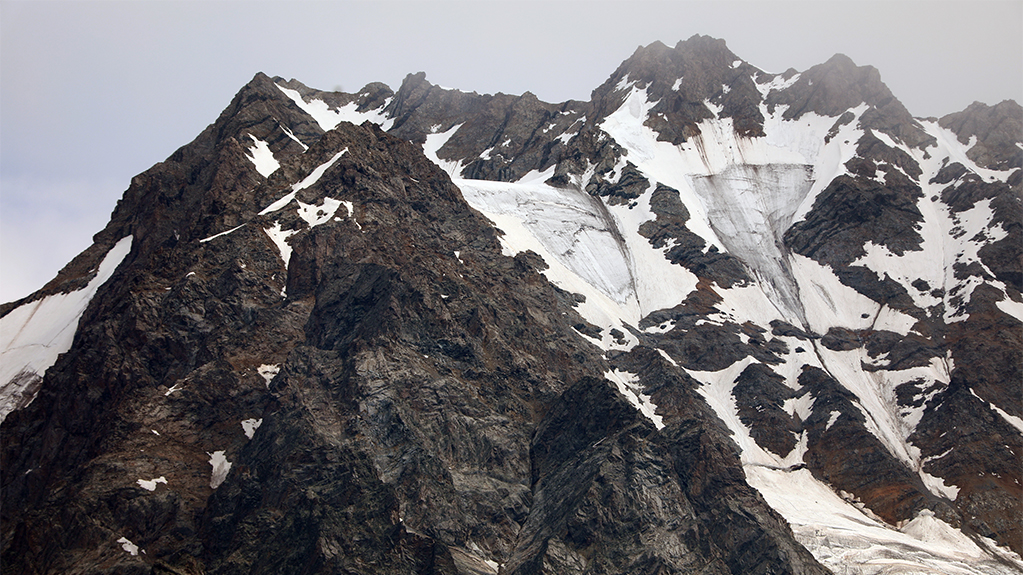
Tbilisa glacier where the cataclysm originated. Photo © Mtisambebi.ge
This was predictable
In addition to the forensic examination, the scientific examination of the case is also interesting. The National Environmental Agency has not yet presented the final report on the Shovi disaster. In their preliminary report, they stated that multiple factors had conspired - rockfall, ice mass collapse, overflow of subglacial waters, torrential flow, sharp increase of shore washing - all these processes allegedly developed simultaneously, in 8 minutes. We assembled independent authoritative experts, showed them our video footage from the glacier and the valley, and asked whether these processes were so unexpected for a high-mountainous, seismically unstable, landslide-prone region.
‘‘Because the glaciers are melting intensively, everything else that occurred was just a chain reaction waiting to happen. It makes sense that the events developed in a way they did. It would be strange if they didn’t. This was to be expected,’’ asserts Zurab Javakhishvili, a geophysicist and a professor at Ilia State University.
Experts believe that several figures in the initial assessment of the Environmental Agency are grossly exaggerated.
Lasha Sukhishvili, professor of geography: ‘‘5 million cubic meters of solid material that supposedly came down in Shovi according to that document seems exaggerated to us. We think that the real number was half or a third of the alleged volume. The water needed to trigger this process was estimated at one and a half million cubic meters, Again, we think that this is also an overestimation. 2-3 hundred thousand cubic meters of water could have accumulated at most. So the scale of everything was blown out of proportion.’’
The state has restricted information about the Shovi tragedy not only to the independent media, to the public, but even to field specialists. Foreign colleagues helped them piece together the picture by sharing the latest satellite photos.
No special detection/monitoring equipment is installed in the prospective disaster zone. But the process which started from the glacier and developed in the valley, was detected by a seismograph – a device used to measure and record vibrations in the earth’s crust during earthquakes - in the village of Ghari, 26 kilometers from Shovi. Vibrations were also detected by the Shenako seismological station in Tusheti. According to these data, the torrent reached the resort 8 minutes after the rock avalanche set it off.
Zurab Javakhishvili, geophysicist: ‘‘If early warning systems had been in place, 8 minutes would have been more than enough to get the vacationers and residents to safety. In addition to being aware of the dangers, it is important people know how to react and to demarcate safety zones. In Shovi, safety was just a few meters away from any affected spot. Therefore, these 8 minutes would be plenty had the early warning systems been installed.’’
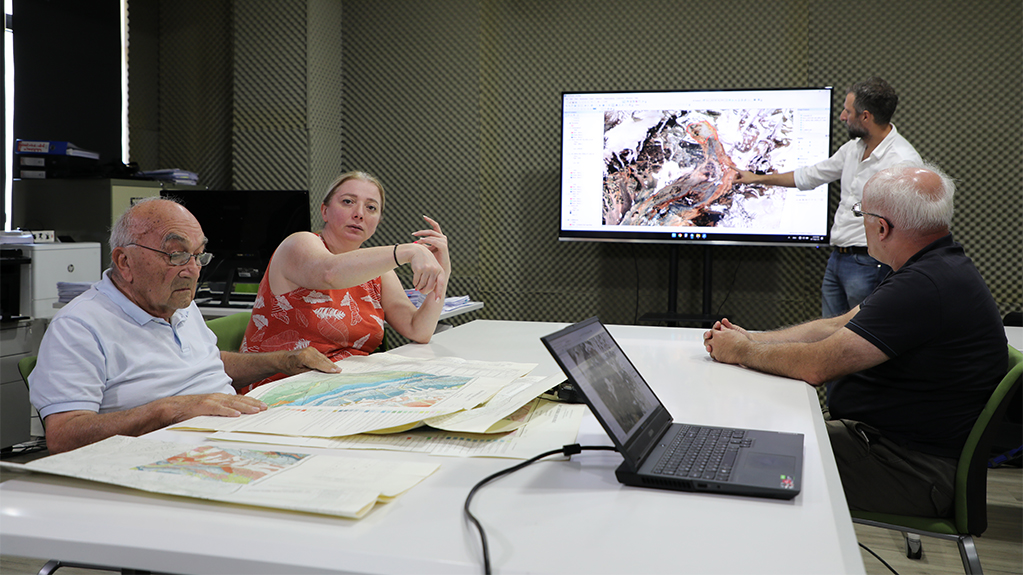
According to scientist's assessments, the Shovi disaster was foreseeable. Photo © Mtisambebi.ge
‘‘The formation of such a system countrywide begins this year, and in 2-3 years, Georgia will be completely covered with emergency notification stations, which will provide crucial data for prevention,’’ The Minister of Environmental Protection made this promise in 2018. This is one of the most popular unrealized promises we have been hearing from various state officials over the years. For 12 years, the project of early warning systems moves from paper to paper, from one report to another, from program to program.
Even now, 74 million dollars have been allocated for disaster risk reduction, of which 36 million are grants, but we still do not have a nationwide early warning system, except for in Devdoraki and the Vere Valley.
Tea Godoladze, director of the National Seismic Monitoring Center: ‘‘When you know you've got a glacial river and you've got cottages in the projected path [of a landslide], where people are resting on their pillows, you have to have these systems in place, and if you don't, you have to get those people out of there, because it is just a matter of time when the disaster strikes. It will happen next year and a year after that.
Shota Adamia, geologist, former minister of environmental protection: ‘‘In civilized states, you would not settle people where there is danger of collapse. And that this is a risk zone has been shown at least since 1972.’’
In the wake of the Shovi disaster, the authorities began to talk about how ineffective and unreliable the early warning systems can be - the most effective tool for reducing the risk of natural disasters that mankind has so far invented.
Lasha Sukhishvili, geographer: ‘‘The rock avalanche material remains on the glacier. When additional agents, such as water, will bring this material down upon Shovi again is another matter and needs research. There are other glacial valleys on top of Shovi, which are undergoing similar processes that developed on Tbilisa.
18 meter hotels right in the death zone
Although we have known about natural hazards in Shovi since at least 1972, and despite the annual reports of the Environmental Agency, where Shovi is systematically classified as a high-risk area, in December of last year, the Oni City Council granted rights to groups affiliated with the ruling party Georgian Dream to build 18-meter hotels right in the death zone.
The Ministry of Economy contracted Art Studio Project LLC to create a General Development Plan for Shovi Resort for half a million.
By law, natural hazards have to be assessed by a specialist within the general development plan. In the case of Shovi, this was done by a geologist Archil Maghalashvili. At one of the meetings held after the Shovi tragedy, he was asked whether he felt guilty for the accident in Shovi.
‘‘No, because I’ve written everything down,’’ he responded.
Let’s see what the Shovi development plan has to say about natural hazards – just two sentences. The first simply says that the risks have been studied. The other says that the planned construction does not fall within the danger zone.
Most of the 18-meter hotel buildings along with their attractions were planned where we had the biggest casualties.
At the insistence of the Ministry of Economy, the General Development Plan of Shovi was approved by the City Council without the document passing the mandatory strategic environmental assessment, which is a violation of the law.
An investigation by Mountain Stories showed that the disaster in Shovi had been expected for decades. This was corroborated by dozens of documents, qualified studies, geological maps, and prior precedents. Despite this, not even a single evacuation plan, board, or a sign was in place in the resort area. Due to the criminal indifference of the authorities, the dam on the Buba River, such as the one that saved the occupants of Sunset Hotel, and the absence of which killed all occupants of the cottages, was never built. The rescue operation after the disaster was uncoordinated. There was no protocol, the rescuers did not have the necessary equipment, and the most crucial first hours were wasted. People were left alone face to face with death. The rescue operation started with a few-hour delay and got suspended as soon as dusk fell. Throughout the night, helicopters were grounded, rescuers suspended the search, and no drones were used. The authorities started to cover up the evidence of their own impotence and incompetence at dawn.
Proper investigative actions were not carried out, the bodies were transferred to the morgue bypassing mandatory procedures, which made it impossible to determine the exact cause or time of death.
High officials of the government called the people abandoned by them in the ordeal liars, as they themselves spewed lies of their own from the parliamentary tribune, such as - bad weather on August 3 in all of Georgia and the ineffectiveness of early warning systems in other countries.
The entire state machine worked in synchrony during the days of the search, so that no unwanted information would leak from the scene of the tragedy. Now, it works to ensure that all public agencies are closed and public information is inaccessible to critical media and independent scientists.
33 people lost their lives in the Shovi tragedy. By the decision of the Prime Minister, the government is offering a compensation in the amount of 20 thousand GEL to the families of the victims.
Author: Gela Mtivlishvili





